Analysis of Hydrodynamic Behavior of the Floating Tapered Trash Intercepting Net in Currents
Abstract
1. Introduction
2. Numerical Model
3. Numerical Method
3.1. Motion Equations of the Netting
3.2. Hydrodynamic Loads on Nets
4. Experimental Validation
5. Results and Discussion
5.1. Effect of the Water Depth
5.2. Effect of the Intercepting Rate of TINs
5.3. Effect of Longitudinal and Transversal Ropes
6. Conclusions
Author Contributions
Funding
Data Availability Statement
Conflicts of Interest
References
- Swift, M.R.; Fredriksson, D.W.; Unrein, A.; Fullerton, B.; Patursson, O.; Baldwin, K. Drag force acting on biofouled net panels. Aquacult. Eng. 2006, 35, 292–299. [Google Scholar] [CrossRef]
- Liu, L.; Kinoshita, T.; Wan, R.; Bao, W.; Itakura, H. Experimental investigation and analysis of hydrodynamic characteristics of a net panel oscillating in water. Ocean Eng. 2012, 47, 19–29. [Google Scholar] [CrossRef]
- Xu, T.; Dong, G.; Tang, M.; Liu, J.; Guo, W. Experimental analysis of hydrodynamic forces on net panel in extreme waves. Appl. Ocean Res. 2021, 107, 102495. [Google Scholar] [CrossRef]
- Shimizu, H.; Mizukami, Y.; Kitazawa, D. Experimental study of the drag on fine-mesh netting. Aquacult. Eng. 2018, 81, 101–106. [Google Scholar] [CrossRef]
- Chen, Q.; Bi, C.; Zhang, Z.; Zhao, Y. Hydrodynamic effect of different biofouling types on aquaculture netting. Ocean Eng. 2023, 279, 114430. [Google Scholar] [CrossRef]
- Dong, S.; You, X.; Hu, F. Effects of wave forces on knotless polyethylene and chain-link wire netting panels for marine aquaculture cages. Ocean Eng. 2020, 207, 107368. [Google Scholar] [CrossRef]
- Balash, C.; Colbourne, B.; Bose, N.; Raman-Nair, W. Aquaculture Net Drag Force and Added Mass. Aquacult. Eng. 2009, 41, 14–21. [Google Scholar] [CrossRef]
- Wan, R.; Guan, Q.; Li, Z.; Hu, F.; Dong, S.; You, X. Study on hydrodynamic performance of a set-net in current based on numerical simulation and physical model test. Ocean Eng. 2020, 195, 106660. [Google Scholar] [CrossRef]
- Bi, C.; Zhao, Y.; Dong, G.; Wu, Z.; Zhang, Y.; Xu, T. Drag on and flow through the hydroid-fouled nets in currents. Ocean Eng. 2018, 161, 195–204. [Google Scholar] [CrossRef]
- Bi, C.; Balash, C.; Matsubara, S.; Zhao, Y.; Dong, G. Effects of cylindrical cruciform patterns on fluid flow and drag as determined by CFD models. Ocean Eng. 2017, 135, 28–38. [Google Scholar] [CrossRef]
- Wang, G.; Martin, T.; Huang, L.; Bihs, H. Modelling the flow around and wake behind net panels using large eddy simulations. Ocean Eng. 2021, 239, 109846. [Google Scholar] [CrossRef]
- Wang, G.; Martin, T.; Huang, L.; Bihs, H. An improved screen force model based on CFD simulations of the hydrodynamic loads on knotless net panels. Appl. Ocean Res. 2022, 118, 102965. [Google Scholar] [CrossRef]
- Wang, B.; Wang, X.; Gao, S.; Qiao, D.; Li, Y.; Deng, Z.; Ou, J. Numerical Simulation of Hydrodynamic Forces Acting on Curved Shape Trash Intercepting Net in Nuclear Power Plant Under Regular Waves. China Ocean Eng. 2024, 38, 983–998. [Google Scholar] [CrossRef]
- Wu, Q.; He, G.; Wen, H.; Lin, X.; He, S.; Chang, X. Study on Cooling Water Source Seawater Filtration System of Nuclear Power Plant. IOP Conf. Series Earth Environ. Sci. 2020, 514, 42014. [Google Scholar] [CrossRef]
- Jiang, Z.; Wang, T.; Wang, B.; Xu, T.; Ma, C.; Shen, K. Numerical Investigation of the Hydrodynamic Behavior of Trash-Blocking Nets for Water Intake Engineering of Nuclear Power Plant. Fluids 2022, 7, 234. [Google Scholar] [CrossRef]
- Sun, Z.; Song, Y.; Xie, M.; Hou, Z.; Wang, H. Dynamic responses of a novel floating tapered trash blocking net system due to wave-current combination. Ocean Eng. 2022, 266, 113141. [Google Scholar] [CrossRef]
- Xie, M.; Li, S.; Mu, Y.; Wei, Y.; Xu, T.; Sun, Z.; Yuan, C. Experimental investigation on the mooring dynamics of the flexible trash intercept net under wave-current combined actions. Ocean Eng. 2023, 268, 113544. [Google Scholar] [CrossRef]
- Gerhard, K. Fiber Ropes for Fishing Gear, FAO Fishing Manuals; Fishing News Books Ltd.: Farnham, UK, 1983; pp. 81–124. [Google Scholar] [CrossRef]
- Choo, Y.I.; Casarella, M.J. Hydrodynamic resistance of towed cables. J. Hydronautics 1971, 5, 126–131. [Google Scholar] [CrossRef]
- Li, Y.-C. Hydrodynamic Behavior of Net Cages in the Open Sea. In Handbook of Coastal and Ocean Engineering; World Scientific Connect: Singapore, 2018; pp. 855–888. [Google Scholar] [CrossRef]
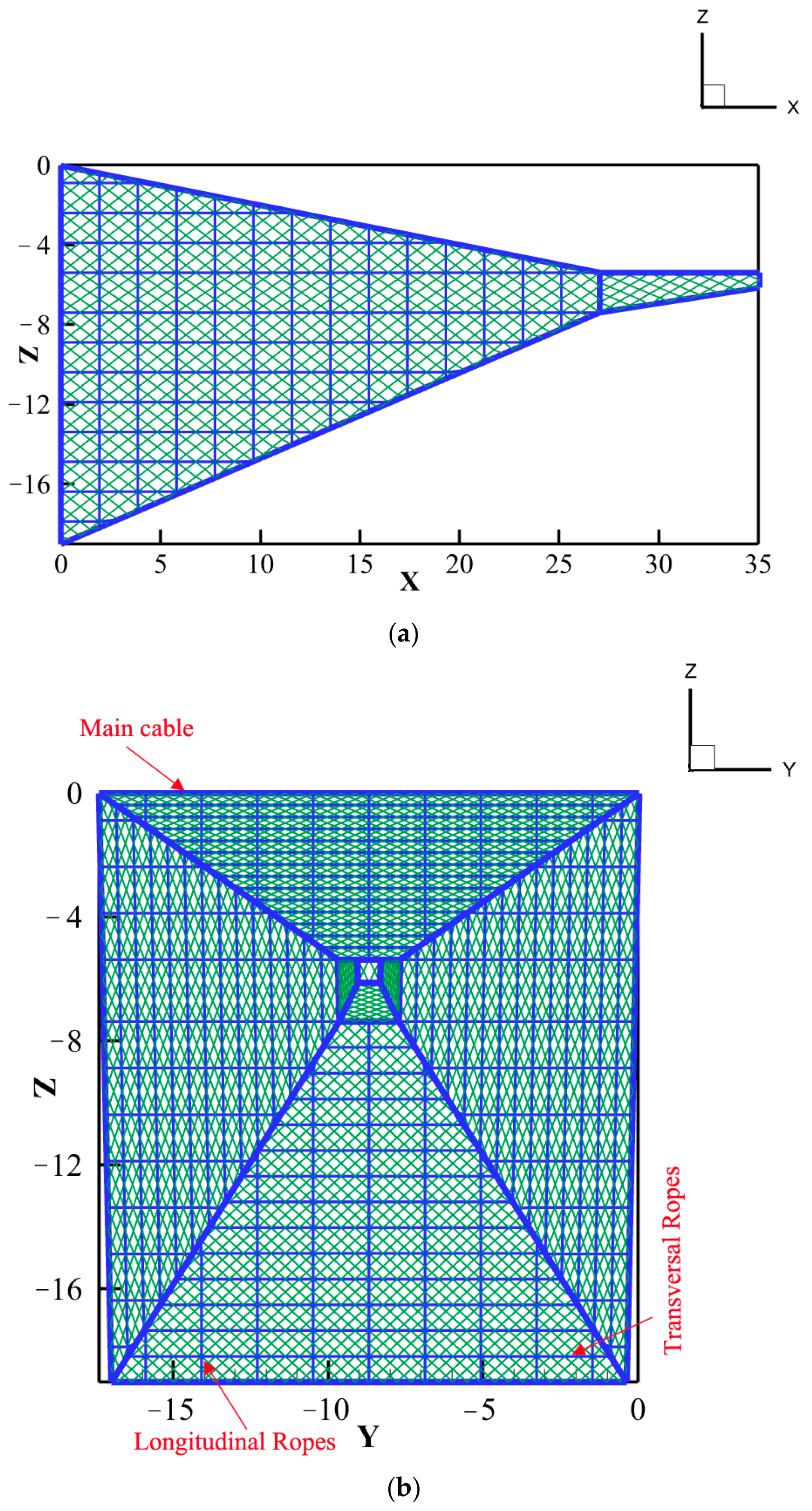
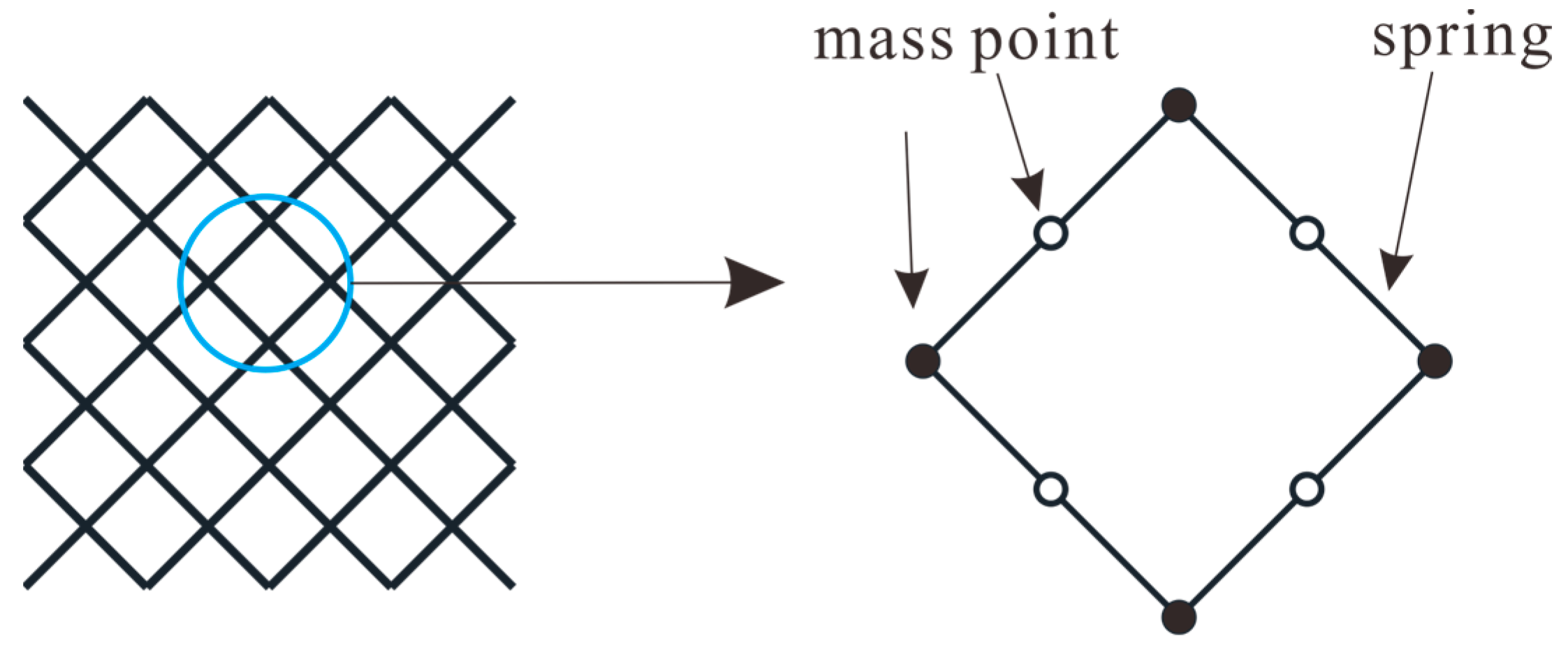
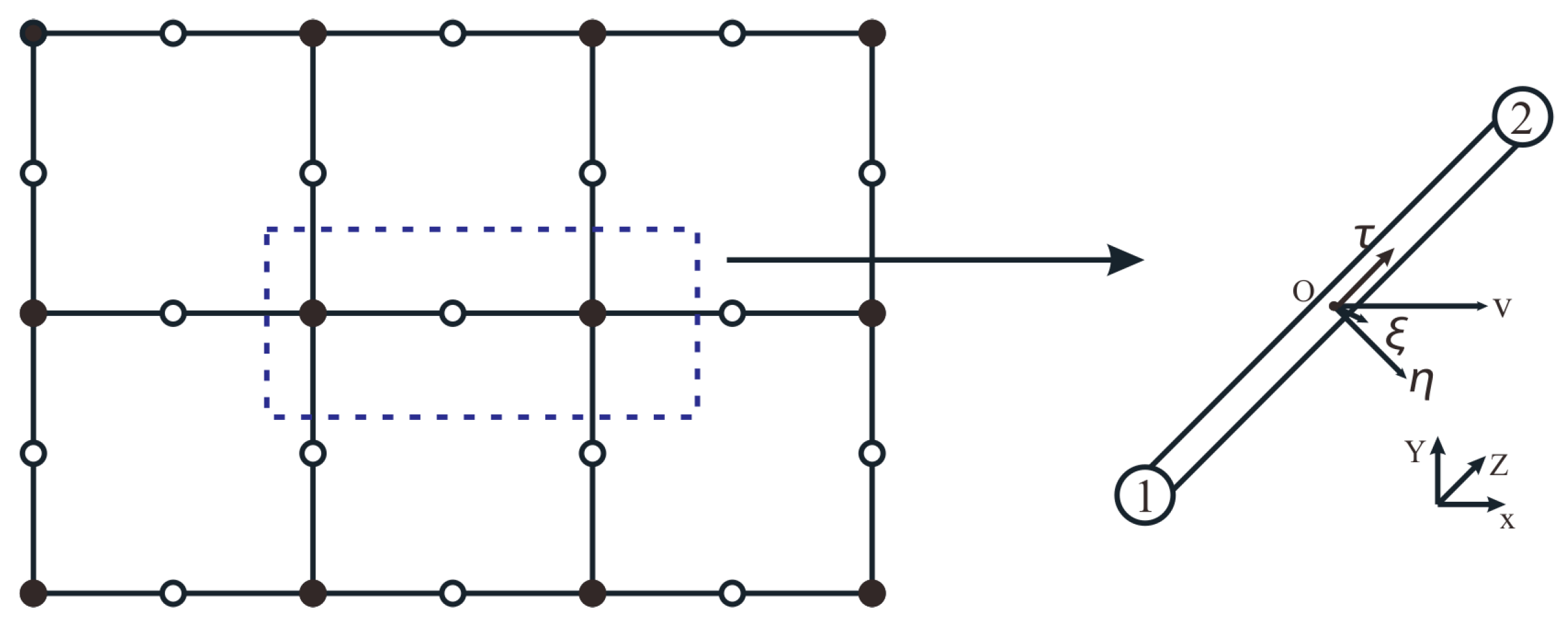

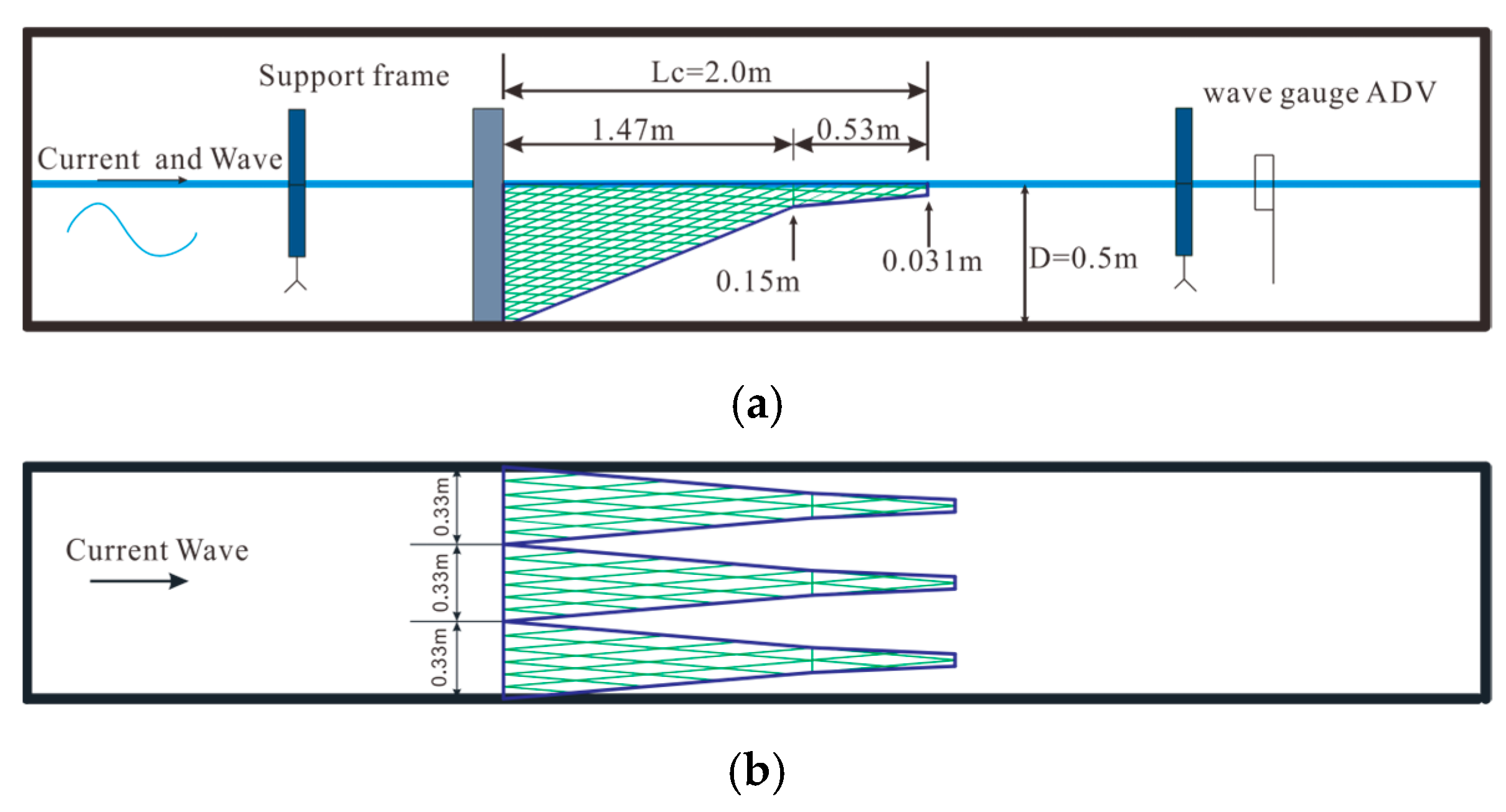


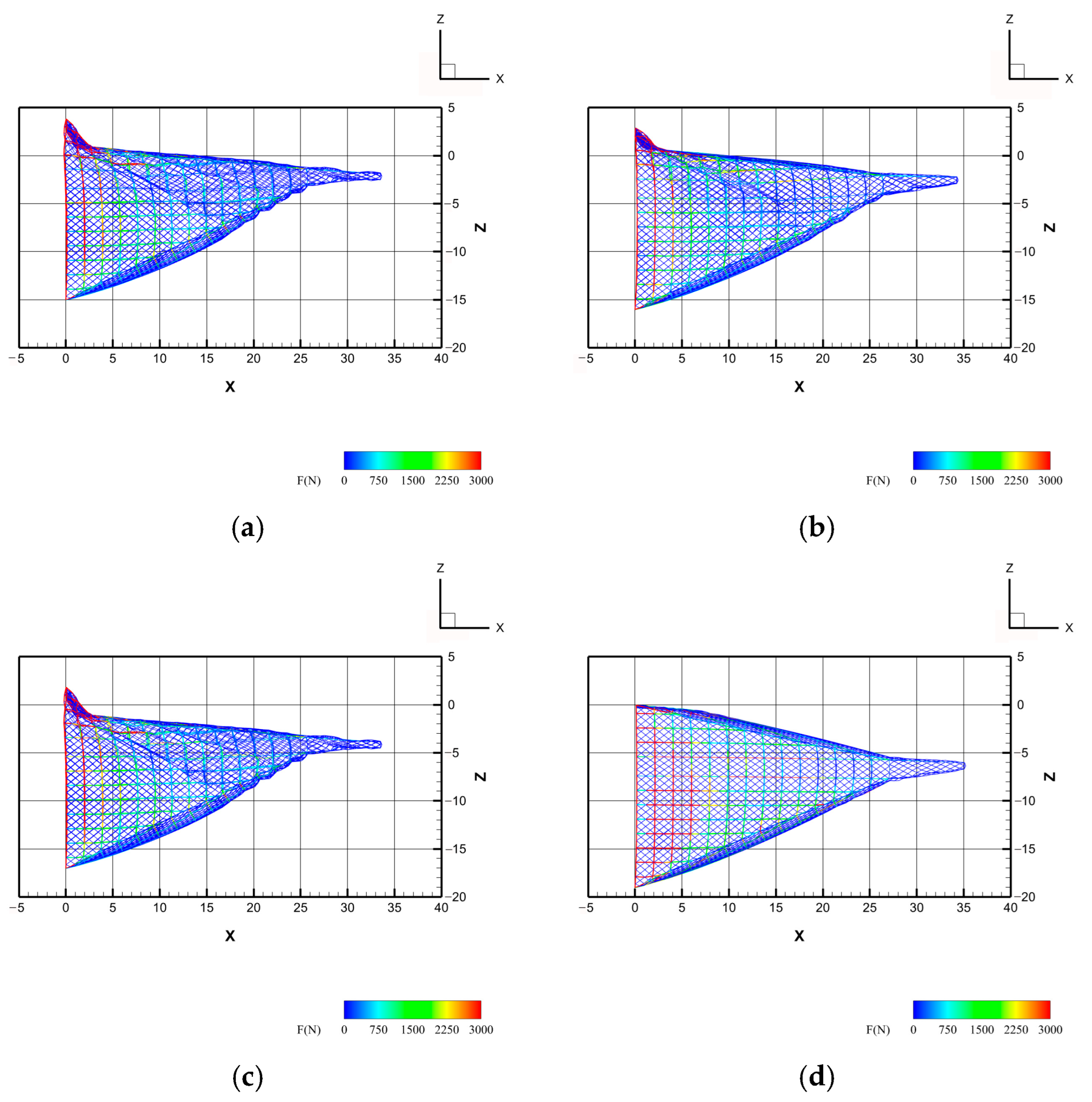

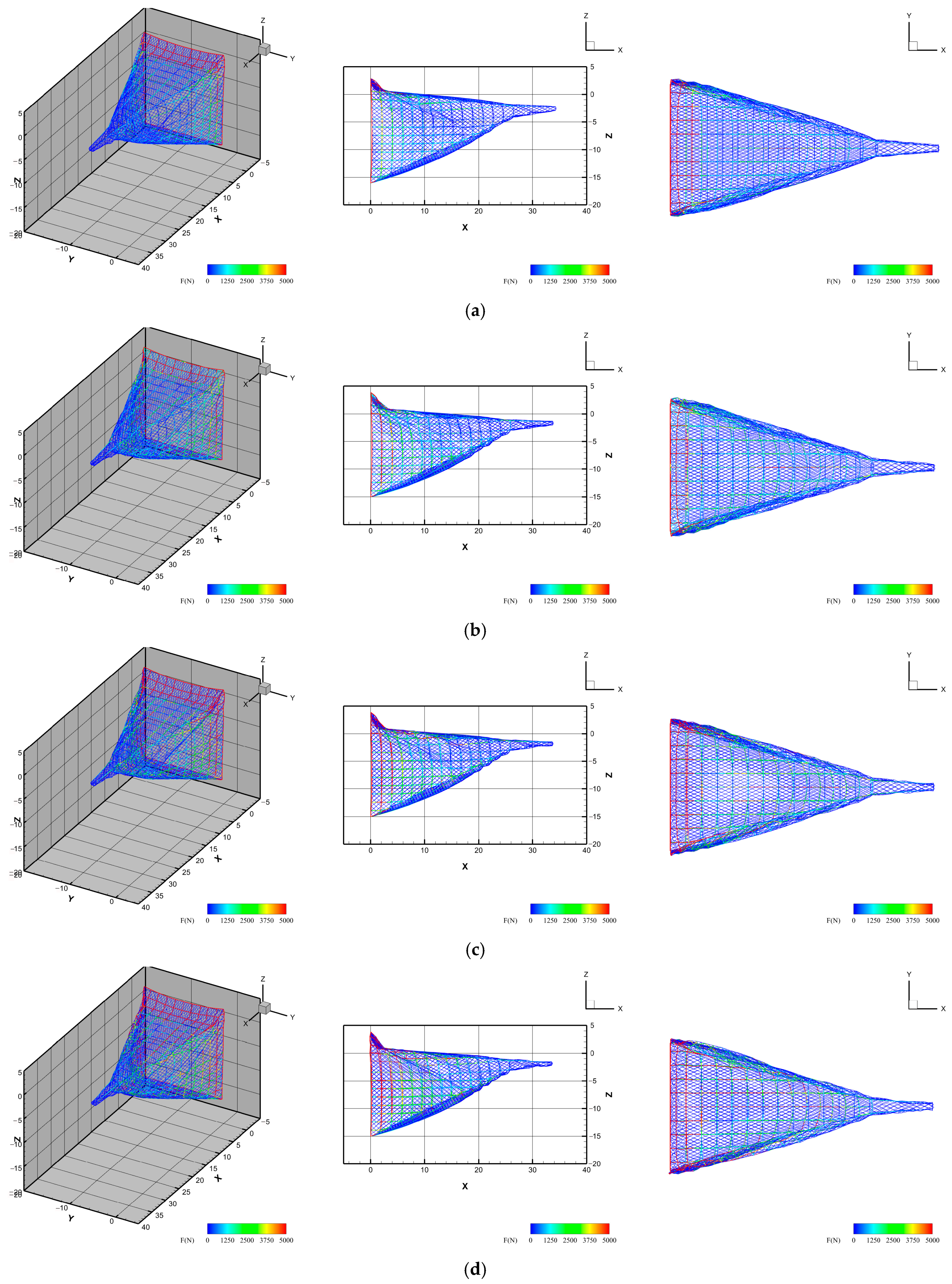

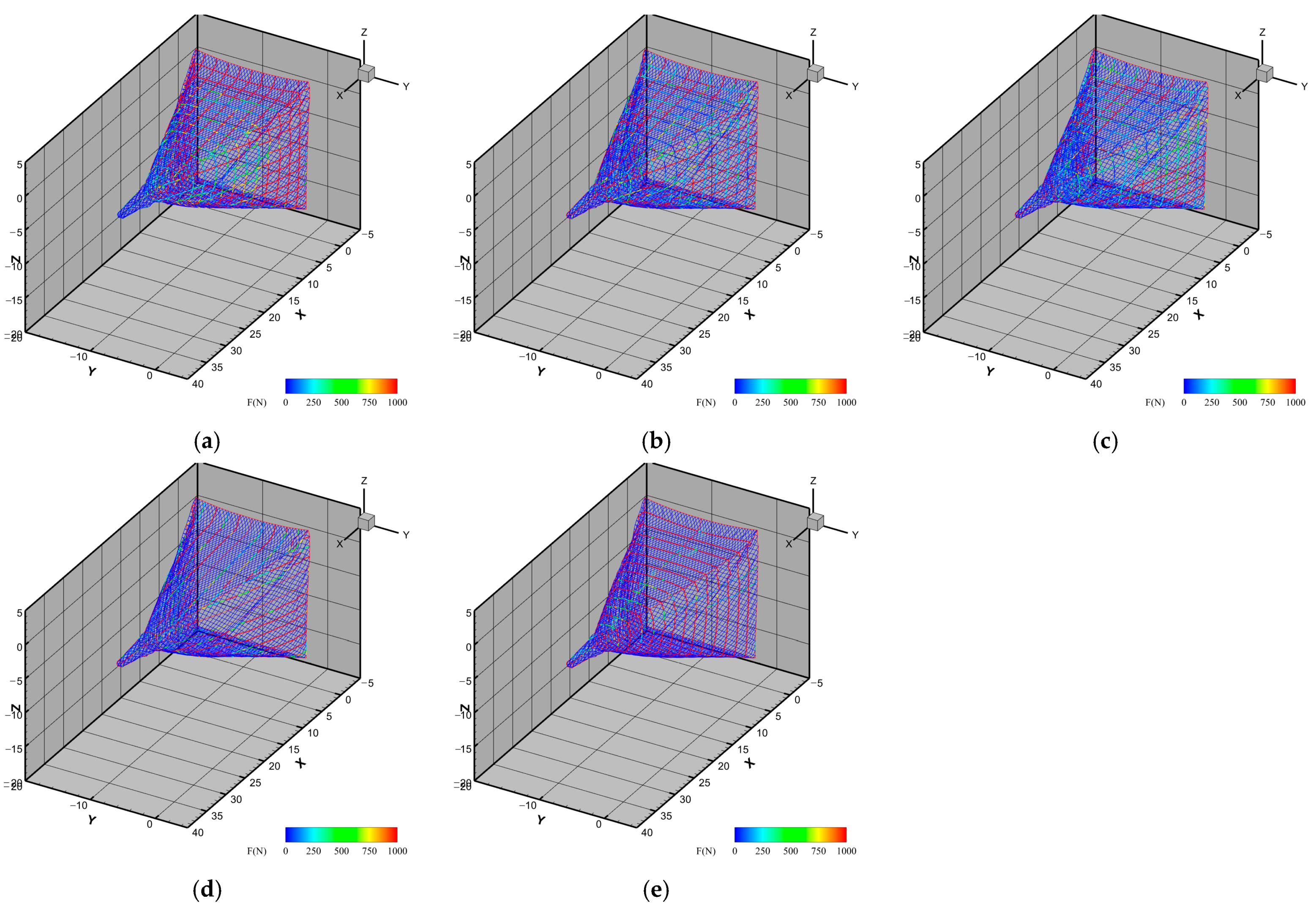
| Parameters | Value | Unit |
|---|---|---|
| Mesh size | 3 × 3 | mm |
| Twine diameter | 0.6 | mm |
| Diameter of longitudinal/transversal ropes | 8.0 | mm |
| Upper width of opening | 17.4 | m |
| Lower width of opening | 16.6 | m |
| Height | 19.0 | m |
| Length | 35.0 | m |
| Elastic modulus | 1.0 | GPa |
| Density | 930.0 | kg/m3 |
| No. | Water Depth (m) | MC (kN) | TAF (kN) | TRF (kN) | LRF (kN) | Net (N) |
|---|---|---|---|---|---|---|
| 1 | 15 | 3.59 | 5.09 | 7.50 | 6.67 | 35.87 |
| 2 | 16 | 4.74 | 6.29 | 9.85 | 8.87 | 41.29 |
| 3 | 17 | 5.83 | 7.43 | 12.77 | 11.41 | 59.65 |
| 4 | 19 | 7.19 | 8.40 | 19.59 | 14.98 | 72.72 |
| No. | Intercepting Rate (%) | MC (kN) | TAF (kN) | TRF (kN) | LRF (kN) | Net (N) |
|---|---|---|---|---|---|---|
| 1 | 0 | 4.74 | 6.29 | 9.85 | 8.87 | 41.29 |
| 2 | 20 | 5.88 | 7.34 | 12.27 | 10.91 | 58.67 |
| 3 | 40 | 9.66 | 12.05 | 20.16 | 17.92 | 133.66 |
| 4 | 60 | 13.27 | 17.40 | 29.76 | 26.80 | 167.92 |
| 5 | 80 | 18.94 | 23.63 | 39.53 | 35.15 | 188.90 |
| No. | Transverse Ropes Diameter (mm) | Longitudinal Ropes Diameter (mm) | MC (kN) | TAF (kN) | TRF (kN) | LRF (kN) | Net (N) |
|---|---|---|---|---|---|---|---|
| 1 | 8 | 8 | 4.74 | 6.29 | 9.85 | 8.87 | 41.29 |
| 2 | 8 | 10 | 4.91 | 6.88 | 9.24 | 9.97 | 43.43 |
| 3 | 10 | 8 | 4.85 | 6.81 | 10.41 | 8.18 | 44.43 |
| 4 | - | 8 | 4.59 | 7.23 | - | 14.94 | 45.34 |
| 5 | 8 | - | 4.41 | 7.88 | 15.24 | - | 46.24 |
Disclaimer/Publisher’s Note: The statements, opinions and data contained in all publications are solely those of the individual author(s) and contributor(s) and not of MDPI and/or the editor(s). MDPI and/or the editor(s) disclaim responsibility for any injury to people or property resulting from any ideas, methods, instructions or products referred to in the content. |
© 2025 by the authors. Licensee MDPI, Basel, Switzerland. This article is an open access article distributed under the terms and conditions of the Creative Commons Attribution (CC BY) license (https://creativecommons.org/licenses/by/4.0/).
Share and Cite
Yu, G.; Sun, Z.; Lin, Z.; Xu, T.; Xie, M. Analysis of Hydrodynamic Behavior of the Floating Tapered Trash Intercepting Net in Currents. Water 2025, 17, 3216. https://doi.org/10.3390/w17223216
Yu G, Sun Z, Lin Z, Xu T, Xie M. Analysis of Hydrodynamic Behavior of the Floating Tapered Trash Intercepting Net in Currents. Water. 2025; 17(22):3216. https://doi.org/10.3390/w17223216
Chicago/Turabian StyleYu, Gangjie, Zhenzhou Sun, Zhendong Lin, Tiaojian Xu, and Mingxiao Xie. 2025. "Analysis of Hydrodynamic Behavior of the Floating Tapered Trash Intercepting Net in Currents" Water 17, no. 22: 3216. https://doi.org/10.3390/w17223216
APA StyleYu, G., Sun, Z., Lin, Z., Xu, T., & Xie, M. (2025). Analysis of Hydrodynamic Behavior of the Floating Tapered Trash Intercepting Net in Currents. Water, 17(22), 3216. https://doi.org/10.3390/w17223216






